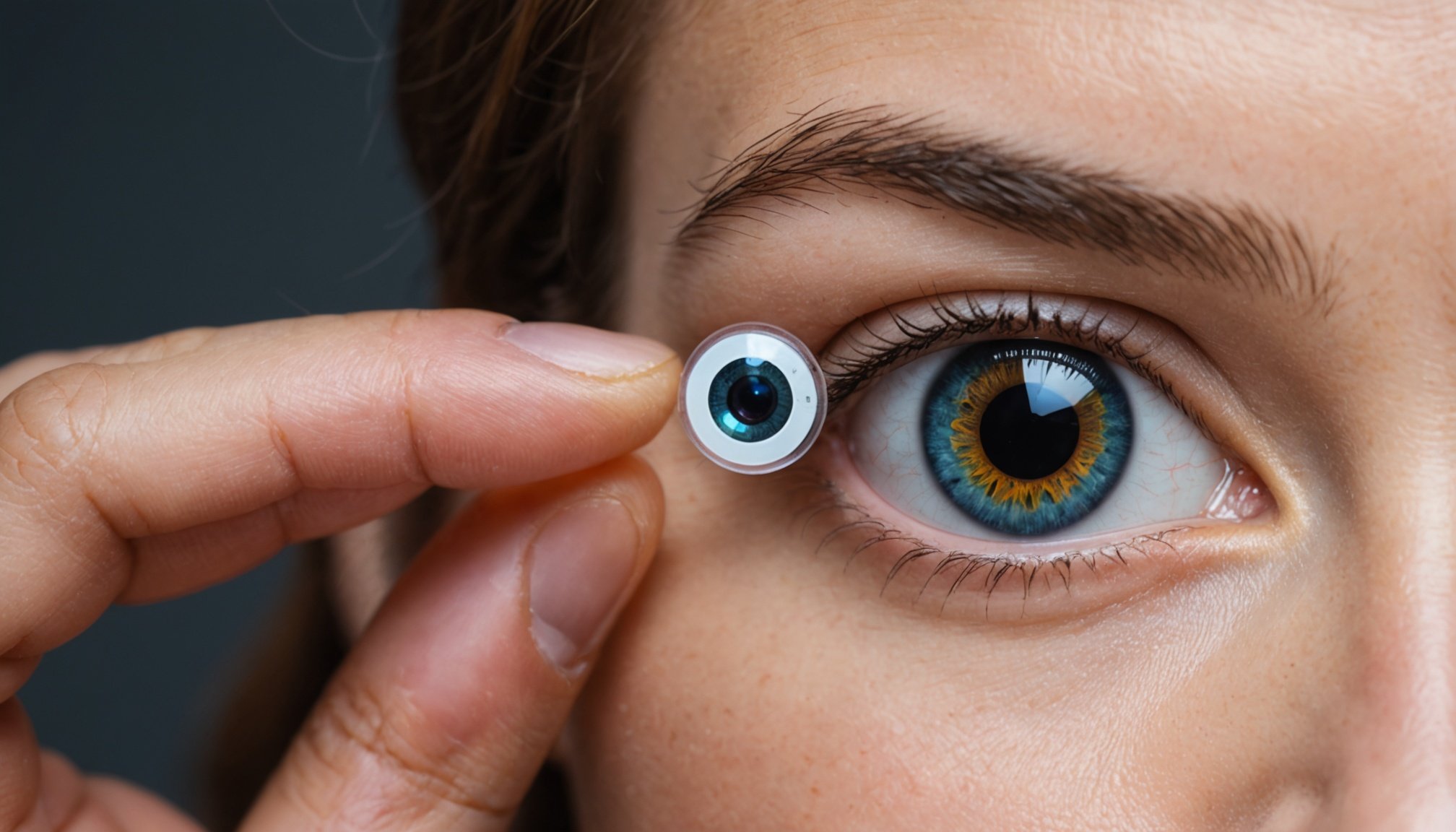Unveiling Revolutionary Smart Contact Lens Technology: Real-Time Health Monitoring at Your Fingertips
The Evolution of Contact Lenses: From Vision Correction to Health Monitoring
Contact lenses have come a long way since their inception as simple vision correction tools. Today, they are transforming into sophisticated wearable devices that not only correct vision but also monitor health metrics, provide augmented reality experiences, and even deliver medication. This evolution is driven by cutting-edge technology that integrates sensors, microchips, and wireless connectivity into these tiny, yet powerful, devices.
Smart Contact Lenses: The Future of Health Monitoring
Smart contact lenses are at the forefront of this technological revolution. These lenses are equipped with sensors that can monitor various health metrics in real-time. For instance, they can track glucose levels, a feature pioneered by companies like Google and Novartis. By analyzing tear fluid, these lenses eliminate the need for painful finger-prick tests, providing diabetics with a non-invasive and continuous monitoring system[2].
Also to discover : Transforming solar energy: unveiling cutting-edge innovations in panel technology for enhanced efficiency and cost-effectiveness
Key Features of Smart Contact Lenses for Health Monitoring:
- Track glucose levels in real-time
- Monitor intraocular pressure (IOP) for glaucoma detection
- Detect biomarkers for diseases such as dry eye
- Provide real-time data to medical professionals
- Wireless transmission of health data
- Compatibility with a wide range of temperatures
Advanced Sensors and Technology
The technology behind these smart contact lenses is remarkably advanced. Researchers have developed miniature spiral circuits that change their natural vibration patterns in response to minute changes in eye pressure and diameter. These circuits are sandwiched between layers of polydimethylsiloxane, a common contact lens material, and can wirelessly transmit pressure data to a computer via a coil held near the lens[1].
Glaucoma Detection: A Critical Application
One of the most significant applications of smart contact lenses is in the early detection and monitoring of glaucoma. Glaucoma is a condition characterized by increased intraocular pressure (IOP) that can lead to vision loss if not managed properly. Traditional methods of measuring IOP can be invasive and uncomfortable, but smart contact lenses offer a continuous and non-invasive solution. These lenses can monitor IOP across a wide range of temperatures, ensuring accurate readings regardless of environmental conditions[1].
Also read : Revolutionizing coastal pollution monitoring: unveiling advanced ai solutions for real-time tracking
Augmented Reality (AR) and Enhanced Vision
Beyond health monitoring, smart contact lenses are also being developed to enhance vision and provide augmented reality experiences. Companies like Mojo Vision and XPANCEO are working on AR-enabled lenses that can project digital information directly into the wearer’s field of view. These lenses can navigate, communicate, and even entertain, blending the digital and physical worlds seamlessly[2][3].
Image Projection and Display Quality
The AR lenses developed by XPANCEO are particularly noteworthy for their advanced display technology. By reducing the resolution in the peripheral vision area, these lenses minimize the load on the video controller, allowing for smaller packaging and lower power consumption. This technology ensures that the brightness loss from the display to the eye is reduced, and the total power consumption is as low as 1-3 µW, significantly less than comparable AR glasses[3].
Testing and Quality Assurance
As smart contact lenses become more sophisticated, the need for rigorous testing and quality assurance grows. Radiant Vision Systems has developed a custom testing system specifically for AR contact lenses, which measures critical parameters such as field of view, brightness of virtual images, contrast, and line sharpness. This system replicates the human eye’s field of view and entrance pupil, ensuring that the display quality meets strict medical guidelines[3].
Key Parameters for Testing AR Contact Lenses:
- Field of View: Ensuring users can see images from any angle
- Brightness of Virtual Images: Objective testing to prevent eye damage
- Contrast: Measuring how clearly an image stands out from the background
- Adaptation to Weather Conditions: Adjusting brightness to different environments
- Gradient of Intensity Across the Field: Correcting image brightness at the edges
- Line Sharpness: Ensuring fine lines and details are clear
Bioengineered and Therapeutic Lenses
In addition to smart and AR lenses, bioengineered and therapeutic contact lenses are also making significant strides. These lenses are designed to adapt to the wearer’s eye for enhanced comfort and functionality. For example, drug-delivering lenses can release controlled doses of medication directly to the eye, improving treatment outcomes for conditions like glaucoma or infections. Wound-healing lenses coated with healing agents can protect the eye while accelerating tissue regeneration post-surgery[2].
Myopia Control and Specialized Lenses
Specialized contact lenses are being developed to address specific eye conditions. Myopia control lenses, for instance, use innovative optical designs to slow the progression of myopia in children and adolescents. Bifocal and multifocal lenses provide clear vision at all distances, making them an attractive option for individuals with presbyopia[4].
Enhanced Comfort and Sustainability
Comfort remains a top priority for contact lens users, and recent innovations have focused on enhancing this aspect. Water gradient soft contact lenses create a smooth transition from a highly breathable core to a soft, hydrophilic surface, providing extreme comfort. AI algorithms are used to optimize lens fit, reducing complications and enhancing comfort. Additionally, advancements in materials like graphene and antimicrobial coatings are making contact lenses more durable and safer to wear[2][4].
Accessibility and Affordability
As technology advances, efforts are being made to make contact lenses more accessible and affordable worldwide. Innovations in production methods aim to lower costs without compromising quality. Subscription services and global distribution partnerships with NGOs and healthcare organizations help bring high-quality lenses to underserved communities, addressing vision care disparities[2].
Practical Insights and Actionable Advice
For those interested in adopting these new technologies, here are some practical insights and actionable advice:
Educating Patients and Staff
Optometry practices play a crucial role in adopting new contact lens technologies. Educating patients about the latest options and training staff on new products are essential steps. Continuous education and optometry training enable staff to prescribe and manage advanced contact lens options effectively[4].
Integrating New Technologies into Practice
Optometry practices can integrate new contact lens technologies by using tools like Weave, which offers comprehensive solutions for patient communication, digital forms, and online reviews. These tools help streamline patient care and improve practice efficiency[4].
Staying Updated with the Latest Advancements
Staying informed about the latest advancements in contact lens technology is crucial. Following scholarly articles, attending industry conferences, and participating in online forums can help healthcare professionals stay updated and provide the best care possible.
Smart contact lens technology is revolutionizing the way we approach healthcare and vision correction. With their ability to monitor health metrics in real-time, enhance vision through augmented reality, and deliver medication, these lenses are redefining personal health monitoring. As this technology continues to evolve, it promises a future where healthcare is more connected, convenient, and advanced than ever before.
Table: Comparison of Smart Contact Lens Features
| Feature | Health Monitoring Lenses | AR Lenses | Bioengineered Lenses |
|
|-------------------------------|
|-------------------------------|
| **Health Metrics** | Glucose levels, IOP |
| - |
| **Display Technology** |
| Image projection, reduced resolution|
|
| **Medication Delivery** |
| - | Controlled doses of medication|
| **Comfort** | Wireless transmission | Advanced display technology | Water gradient, AI optimization|
| **Applications** | Glaucoma detection, diabetes | Navigation, communication, entertainment| Myopia control, wound healing|
| **Testing Parameters** | Field of view, brightness | Field of view, brightness, contrast|
|
| **Materials** | Polydimethylsiloxane | Graphene, antimicrobial coatings | Bioengineered materials |
In the words of Dr. Valentyn Volkov, co-founder of XPANCEO, “Smart contact lenses aim to solve the problems of current wearable technology by integrating various traditional device functions into a single interface that is weightless and as natural to the wearer as their own vision.” As we move forward, it’s clear that these lenses are not just a tool for better sight but a gateway to a better, smarter, and more connected world.

